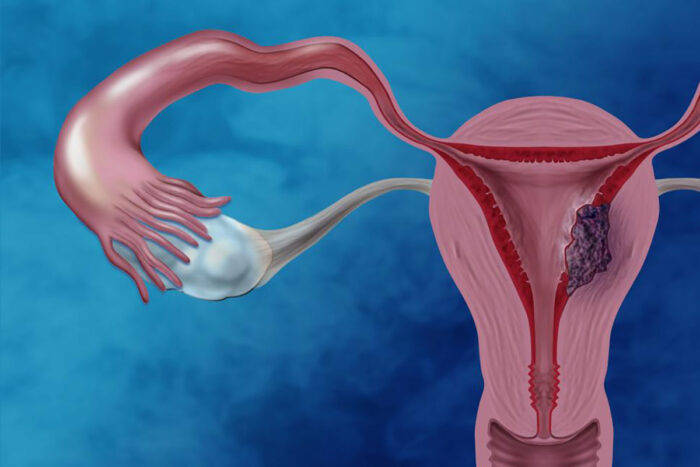Fight against endometrial cancer boosted with new molecular road map
Detailed analysis reveals new drug targets
 Darryl Leja, National Human Genome Research Institute
Darryl Leja, National Human Genome Research InstitutePictured is an illustration of endometrial cancer, showing a tumor growing inside a uterus. A new study offers a road map to understanding the molecular underpinnings of endometrial cancer, which could lead to new therapies. The national research team was co-led by investigators at Washington University School of Medicine in St. Louis.
A new study that reveals the dozens of molecular changes that bring about endometrial cancer offers insight into how physicians might be able to better identify which patients will need aggressive treatment and why a common treatment is not effective for some patients.
The study appears Feb. 13 in the journal Cell.
Funded by the National Cancer Institute, the study also suggests a potential role for already approved drugs that target proteins newly implicated in this disease also commonly known as uterine cancer.
“This study reveals a new dimension of endometrial cancer and moves us closer to identifying new therapeutic targets,” said co-senior author Li Ding, PhD, a professor of medicine at Washington University School of Medicine in St. Louis and a research member of Siteman Cancer Center. “Cancer mutations affect proteins, which are the functional units inside cells. We now have the capacity to understand in detail what the genetic mutations are doing inside the cancer cells, and that can serve as a basis for new treatment strategies.”
The paper builds on work by The Cancer Genome Atlas (TCGA) which identified the genetic underpinnings of the disease in 2013.
“This is like the Google Earth of endometrial cancer,” said Karin Rodland, PhD, of the Department of Energy’s Pacific Northwest National Laboratory (PNNL). “It’s a very comprehensive portrait of this particular cancer type. We tried to measure everything we possibly could. Then we searched for patterns.”
Ding and Rodland are two of five corresponding authors of the paper; David Fenyo, PhD, of New York University School of Medicine is the senior corresponding author. Other corresponding authors are with the Baylor College of Medicine and PNNL. Overall, scientists from more than a dozen institutions contributed to the project.
The team studied 95 uterine tumors and 49 normal uterine tissue samples. Scientists measured the abundance, modifications and locations of many vital molecular players, including genes, proteins, messenger RNAs, circular RNAs, micro RNAs, and evidence of what scientists call “post-translational modifications.” The latter are key to determining when and where proteins, the molecular workhorses of cells, are turned on or off.
The scientists developed a promising new way to identify tumors that are classified incorrectly as not aggressive but that turn out to be just as invasive as a type of tumor that grows quickly and is more likely than other tumors to kill patients.
Currently, the aggressiveness of an endometrial tumor is assessed largely by viewing its cells under a microscope. The team explored a new method that shows how the activity levels of certain proteins clearly differentiate aggressive from less-aggressive tumors.
One analysis, led by co-first author Daniel Cui Zhou, a doctoral student at Washington University, showed how the protein beta-catenin, a well-known actor in many types of cancer, interacts with an important signaling pathway to evade detection and spur cells to grow out of control.
“This is the first delineation of the entire beta-catenin complex in a specific disease,” said Ding, also a research member of The McDonnell Genome Institute at Washington University. “We know it plays roles in endometrial cancer and colorectal cancer, so this is a major step forward in understanding the details of this important cancer driver.”
The team also found that a process that involves packing and unpacking genes happens more often than expected in tumor cells. With more than six feet of DNA squeezed into nearly every human cell, the body must pack it efficiently, but it also needs to unspool the DNA so that other molecular machinery can access it. Analysis led by co-author Alla Karpova, a doctoral student in Ding’s lab, found that a key part of the unspooling process, known as histone acetylation, is very active in endometrial cancer.
“Histone acetylation tends to activate genes, which can drive cancer growth,” Ding said. “In theory, we could use information about histone acetylation to predict how aggressive a tumor is likely to be.”
The team also discovered that small, often overlooked molecules known as circular RNAs seem to be involved in the transformation that cells undergo when they gain the ability to spread. The process is called the endothelial-to-mesenchymal transition and is what makes endometrial cancer deadly.
In addition, the team created a new way to determine which patients are most likely to benefit from a treatment known as checkpoint therapy, in which drugs such as pembrolizumab and nivolumab are used to dodge the barriers that some cancer cells use to evade the immune system. It’s one of many ways scientists are exploring immunotherapy to spur the body’s natural defenses to fight cancer.
Currently in endometrial cancer, physicians use a measurement known as “tumor mutation burden” to determine which patients are most likely to benefit from checkpoint therapy. Based on the measurements of immune activity in this study, the scientists have proposed a new measure focused on how well a patient’s body flags cancer cells and presents them to the body’s immune system for destruction — a key function for checkpoint inhibitors to be effective.
Better insight into exactly who would benefit from the drugs would allow physicians to avoid their use in patients who are unlikely to benefit, sparing them unnecessary side effects.
“Now that we have this insight into proteins, we can start thinking about better therapeutic options at the molecular level for patients who have endometrial cancer,” Ding said. “Drugs target proteins, so this was not possible before we acquired this understanding of tumor proteins. We are much closer to effective personalized treatment with this new study.”






